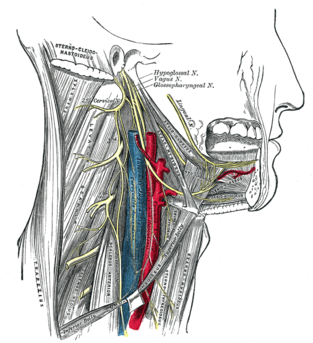Hypoglossal Nerve: Difference between revisions
Ahmed Essam (talk | contribs) No edit summary |
Ahmed Essam (talk | contribs) mNo edit summary |
||
| Line 12: | Line 12: | ||
== lesion == | == lesion == | ||
1/ | '''UMNL:''' | ||
1/ unilateral: deviation of the tongue to the opposite side of the lesion. | |||
2/ | |||
bilateral: inability to protrude the tongue. | bilateral: inability to protrude the tongue. | ||
'''note in both cases there is no wasting or fasciculation'''. | |||
'''LMNL:''' | |||
1/unilateral: deviation of the tongue to the side of the lesion. | |||
2/bilateral: inability to protrude the tongue. | |||
'''note in both cases there is wasting and fasciculation.''' | |||
== References == | == References == | ||
1/Lin HC, Barkhaus PE. Cranial nerve XII: the hypoglossal nerve. Semin Neurol. 2009;29(1):45–52.<ref>1/Catala M, Kubis N. [https://www.sciencedirect.com/science/article/pii/B9780444529022000035 Gross anatomy and development of the peripheral nervous system.] Said G, Krarup C, editors. Handb Clin Neurol. 2013;115:29–41. 2/Lin HC, Barkhaus PE. Cranial nerve XII: the hypoglossal nerve. Semin Neurol. 2009;29(1):45–52.</ref> | 1/Lin HC, Barkhaus PE. Cranial nerve XII: the hypoglossal nerve. Semin Neurol. 2009;29(1):45–52.<ref>1/Catala M, Kubis N. [https://www.sciencedirect.com/science/article/pii/B9780444529022000035 Gross anatomy and development of the peripheral nervous system.] Said G, Krarup C, editors. Handb Clin Neurol. 2013;115:29–41. 2/Lin HC, Barkhaus PE. Cranial nerve XII: the hypoglossal nerve. Semin Neurol. 2009;29(1):45–52.</ref> | ||
<references /> | |||
Revision as of 01:39, 7 February 2021
Introduction[edit | edit source]
It is the 12th cranial nerves that originate from the medulla obligate of the brain stem. It is mainly an efferent nerve for the tongue musculature.
innervation[edit | edit source]
It gives only somatic motor innervation for all extrinsic and intrinsic muscles of the tongue except the palatoglossus, innervated by the vagus nerve.
examination[edit | edit source]
Examining the hypoglossal nerve involves observation of the primary innervation target of the nerve; the tongue. The three observable aspects of the tongue are strength, bulk, and dexterity. Special attention is given when the tongue is weak, atrophied, moving abnormally, or impaired.
lesion[edit | edit source]
UMNL:
1/ unilateral: deviation of the tongue to the opposite side of the lesion.
2/ bilateral: inability to protrude the tongue.
note in both cases there is no wasting or fasciculation.
LMNL:
1/unilateral: deviation of the tongue to the side of the lesion.
2/bilateral: inability to protrude the tongue.
note in both cases there is wasting and fasciculation.
References[edit | edit source]
1/Lin HC, Barkhaus PE. Cranial nerve XII: the hypoglossal nerve. Semin Neurol. 2009;29(1):45–52.[2]
- ↑ physiotutors.Cranial Nerve 12 | Hypoglossal Nerve Assessment for Physiotherapists. available from:https://www.youtube.com/watch?v=e6X8vMYTSHs
- ↑ 1/Catala M, Kubis N. Gross anatomy and development of the peripheral nervous system. Said G, Krarup C, editors. Handb Clin Neurol. 2013;115:29–41. 2/Lin HC, Barkhaus PE. Cranial nerve XII: the hypoglossal nerve. Semin Neurol. 2009;29(1):45–52.







